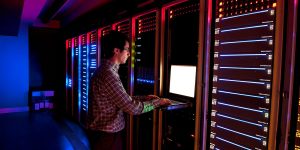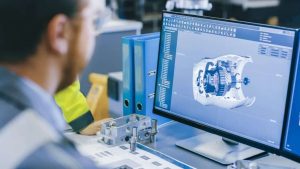
Among the myriad other choices in specifying computer hardware has come another variable: Hard drive or solid-state drive. It may seem at first like a choice that is best made with the bottom line, but there is more that should go into your evaluation.
We first need to describe the difference between the two. That will give us a good start on your decision-making process.
The traditional hard drive is a spinning disc with a magnetic surface that stores information. It has moving parts and is a single structure.
A solid-state drive works like a jump drive or a series of jump drives. Information is stored on a chip that is wired together with other chips. It has no moving parts and is usually composed of several separate chips in a module that is installed on the computer.
The absence of moving parts on SSD units is a point of emphasis. Laptops that are frequently moved from place to place are better served with SSD units because the movement can damage the physical properties of the hard drive.
But desktop and mainframe units may also be well-served by SSD because of the potential for transport, either for a relocation of a facility, rearrangement of building contents, or for shipment to an outside facility for data recovery.
The differences between the two types go beyond that. Let’s review some of the other points.
Durability
Once again, we are talking about moving parts with the HDD. Any regular movement of the computer stands to damage the hard drive. That doesn’t include just movement of the whole computer, though; it also includes environmental movement such as transport of a computer for use in vehicles, or even vibration of a building, such as an office trailer at a highway construction site. SSD will tolerate this jarring more effectively.

Speed
SSD is a faster technology. Because it has no moving parts, it does not have to get up to operating speed. It permits a rapid booting of a computer, and consequently faster handling of files. Traditional HDD technology requires that time of whirring and spinning that gets the unit up to the necessary RPMs for proper operation.
Cost
As a new technology, SSD is, of course, more expensive. The demand for them, of course, will ultimately drive costs down as competition increases and innovation reduces costs. The possibility exists of a cost “arms race”, wherein competitors aggressively work to undercut one another’s prices to capture more market share.
Security
Of course, the overriding concern for many users today is security of data. While encryption and other security features are equally effective on both types of hard drives, the physical durability of SSD wins out again in this category. Lost in the shuffle of concern about hacking is good old-fashion crashing, which is less devastating regarding privacy but equally problematic in data loss. The physically tougher choice wins out, and that is SSD.
Understanding the applications where your computer will operate is essential as you choose between SSD and HDD. The more challenging conditions call for the SSD, but if cost is the most important factor, it’s likely that HDD will fit the bill just fine. The important thing is to evaluate your use before making a choice and to consult someone with expertise.








